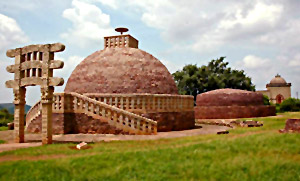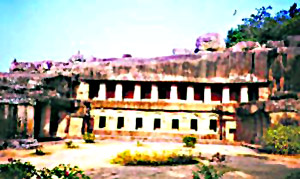 Right after the fall of the Mauryans the Brahmanical dynasties like Sungas and Kanvas emerged and ruled for few years. However the most important part of the post Mauryan period was the arrival of foreign tribal groups into India, like the Indo Greeks. The arrival of the foreign tribes teamed with the various changes in the socio political and even economic level gave rise to almost a new kind of architecture typically termed as the "Post Mauryan Architecture
Right after the fall of the Mauryans the Brahmanical dynasties like Sungas and Kanvas emerged and ruled for few years. However the most important part of the post Mauryan period was the arrival of foreign tribal groups into India, like the Indo Greeks. The arrival of the foreign tribes teamed with the various changes in the socio political and even economic level gave rise to almost a new kind of architecture typically termed as the "Post Mauryan Architecture
Architecture
The Stupa: The original brick stupa built in Asoka`s time was enclosed by a wooden fence. It was later replaced by the massive stone balustrade. It is now surrounds the enlarged monument encased in stone. It consists of octagonal upright posts capped by a continuous coping stone, rounded at the top and fixed to the posts by means of construction of the stone rail is essentially wooden. All the four gateways are covered with the most elaborate sculptures in contrast to the rails that are kept severely plain. Stupa No 3 at Sanchi is also surrounded by rails and gateways of similar design, a portion of which may now be seen in the Indian Museum Calcutta. The Bharhut rail, however, instead of being plain was richly carved.
The Chaitya Hall: The Chaitya Hall at Bhaja, near Poona, was constructed most probably in the times of the Mauryas. It has twenty-seven pillars running along the entire length of the apsidal hall and around the votive chaitya. It is thus dividing it into a central nave and two side aisles. The pillars are plain octagonal shafts, a little over 11 feet in height, and support the barrel-vaulted roof on a framework of curved ribs. Originally it is made of wooden construction. The side aisles is only 31/2 feet wide, are half barrel-vaulted. The votive Chaitya is placed near the back end, and the entrance just opposite to it. Now a lofty open archway is present nearby. The decoration of the facade, as seen in the upper section, indicates a definite advance on what it is seen in the Lomasa Rsi cave. The wooden character of Chaitya Hall is nowhere so emphatically stressed as at Bhaja.
Orissa: Udayagiri and Khandagiri Reliefs
 A few caves in the Udayagiri and Khandagiri hills near Bhuvamesvara contain a number of sculptured friezes and panels. Though they speak nevertheless a distinct local dialect belonging to the common denominator of the art of Madhyadesa. The Manchapuri cave relief in Udayagiri and Anantafupha relies in Khandagiri are both characterized by a robust vitality and vigorous movements. The treatment in these reliefs seems to connect them with main treatment of Sanchi, the treatment of elephants and foliage are particularly noticeable. But the general treatment is course and the movement less vital. Technically the reliefs are less advanced and isolated and compact figures prevent forceful composition.
A few caves in the Udayagiri and Khandagiri hills near Bhuvamesvara contain a number of sculptured friezes and panels. Though they speak nevertheless a distinct local dialect belonging to the common denominator of the art of Madhyadesa. The Manchapuri cave relief in Udayagiri and Anantafupha relies in Khandagiri are both characterized by a robust vitality and vigorous movements. The treatment in these reliefs seems to connect them with main treatment of Sanchi, the treatment of elephants and foliage are particularly noticeable. But the general treatment is course and the movement less vital. Technically the reliefs are less advanced and isolated and compact figures prevent forceful composition.
Yaksa Primitives.
 The Yaksas and Yaksinis were malevolent deities of primitive tribal conception and were worshipped in every village. The earliest stone specimens of such divinities hail from Patna, Parkham i.e. placed near Mathura. Baroda is also placed near Mathura, Besnagar Pawaya i.e. near Gwalior and other places. They are all primitively Indian in form, but they also reflect the currents of the flowing traditions of contemporary civilized practice. Their heavy bulk, their almost archaic and weighty volume, the conflict between fully rounded and modeled volume as seen in the arms, breast and abdomen on the one hand, and flat surface at the back on the other all are related. The treatment of the drapery and the physiognomy form and appearance also seem to indicate that they have a close relation with the figure of the Great Stupa of Sanchi as well as with the Primitive Bodhisattvas of Mathura.
The Yaksas and Yaksinis were malevolent deities of primitive tribal conception and were worshipped in every village. The earliest stone specimens of such divinities hail from Patna, Parkham i.e. placed near Mathura. Baroda is also placed near Mathura, Besnagar Pawaya i.e. near Gwalior and other places. They are all primitively Indian in form, but they also reflect the currents of the flowing traditions of contemporary civilized practice. Their heavy bulk, their almost archaic and weighty volume, the conflict between fully rounded and modeled volume as seen in the arms, breast and abdomen on the one hand, and flat surface at the back on the other all are related. The treatment of the drapery and the physiognomy form and appearance also seem to indicate that they have a close relation with the figure of the Great Stupa of Sanchi as well as with the Primitive Bodhisattvas of Mathura.
Special reference should be made to the elegant figure of a female Chauri bearer found at Didarganji in Patna. This shows a more powerful, developed and highly civilized conception and feeling. Though still exhibiting certain primitive characteristics, it can in no way be considered archaic or primitive.
Andhra Stupas
Undoubtedly the Vengi region carries on the tradition of early Indian art, and serves as a link between the earlier art of Bharhut, BodhGaya and Sanchi on one hand and the later Gupta, Pallava art on the other. In ancient times the earliest specimens of sculptural art from Krishna Godavari delta is known as Vengi. This is hail from Jaggayyapeta and Amaravati and comprised a number of carved marble slabs, presumably of Stupas and railings. These low and highly linearized reliefs belong to the common denominator of form of Bharhut and early Sanchi. But lines in Vengi are much more sensitive and the human forms with their elongated limbs are much more tall and slender. At Amaravati the reliefs are slightly rounder and modeling fuller and more delicate. The sculptures of Amaravati and Nagarjunikonda are fully inspired works and display a mastery in which detailed ornamentation and elegance of figure sculpture are joined in a rare harmony. They enwrap the cultural story of a glorious people who had adopted Buddhism as their creed and linked it with their dynamism both on land and sea as merchants and mariners



















